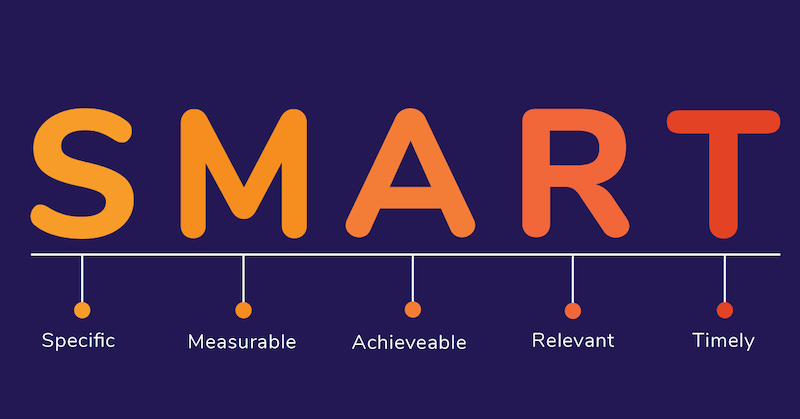How to use SMART goals to grow your business

Specific, Measurable, Achievable, Relevant, Timely = SMART.
SMART goals are a simple tool that will take you past fuzzy goal setting to an actionable plan for results. This article will explain each element of SMART goals and why they are important to a full-funnel marketing plan. We’ll also show you how to use SMART goals to grow your business with examples that take a goal from vague to SMART.
Ready to use SMART goals to grow your business? Let’s get started.

We’ll use an example business to help you learn how to grow your business with SMART goals. Meet Fran, a marketing manager at a SAAS firm called BCorp. Like most marketing managers, Fran is tasked with bringing in more leads. How’s that for a fuzzy goal?
S: Smart
Great goals are defined and focused. The simplest method to get to a specific goal is to ask then answer some probing questions like these:
- What are we trying to do?
- Who is responsible?
- What steps are needed to achieve it?
- If achieved, what happens?
Fran’s fuzzy goal is to “bring in more leads.” Let’s help Fran make that goal more specific. Instead of “bring in more leads” let’s add some specificity, like this:

- Optimizing the SEO of our website.
- Creating fresh content for our website.
- Delivering targeted advertising to corporate targets.
- Gathering leads into a CRM for qualification and nurturing.
M: Measurable
We’re off to a great start, but something important is missing: numbers. Always make sure your goal is measurable. This way you can track and report on your progress and know when you’ve succeeded.
We’ve established that Fran wants more leads. How many? Even one or two leads is an improvement – is that success? This applies to each step Fran is proposing – how much content? How many corporate targets? What marketing channels?
To make the goal more impactful, Fran needs to add measurable numbers and more specifics wherever possible.

- Optimizing the SEO of our blog posts and pages with focus keywords.
- Creating 2 new pieces of valuable content weekly for website publishing.
- Delivering targeted display, social, and search advertising to 50 corporate targets monthly.
- Gathering leads into a CRM for qualification and nurturing.
A: Achievable
Goals must be realistic. If a goal is too lofty or dreamy, your chances of failure are very high. In short, it’s gut-check time. Give yourself a reality check on your goal and numbers. Can you actually reach the goal? What, if anything, might keep you from reaching your goal? Write down the risks.
It’s important that if you identify risks and constraints, you make them clear, especially if the goal came from your boss. You may not be able to adjust the goal, but you have made your position clear and identified potential roadblocks.
After a gut-check, Fran determined that 2 pieces of content weekly wasn’t realistic. Given her staff’s workload and the time it takes to develop quality content, she adjusted the volume. She also took into consideration the resources needed to execute a campaign with 50 targets. Fran’s new goal now reads:

Grow the number of qualified leads for BCorp to 10 per week. We will do this by:
- Optimizing the SEO of our blog posts and pages with focus keywords.
- Creating 1 new piece of valuable content weekly for website publishing.
- Delivering targeted display, social, and search advertising to 20 corporate targets monthly.
- Gathering leads into a CRM for qualification and nurturing.
R: Relevant
Why does this goal matter? What happens if you achieve it? What happens if you fail? When referring to SMART goals, relevant means two things.
- Identifying a real benefit to achieving the goal. No one sets goals for fun. What’s the reason and benefit to yours?
- Considering market realities. Is there increased marketplace competition? Is an economic downturn in the forecast? This might mean adjusting the numbers in your goal.
In Fran’s case, the outlook is quite rosy. She’ll keep her numbers but adds in details and a real benefit to achieving the goal.

Grow the number of qualified leads for BCorp to 10 per week. We will do this by:
- Optimizing the SEO of our blog posts and pages with focus keywords.
- Creating 1 new piece of valuable content weekly for website publishing.
- Delivering targeted display, social, and search advertising to 20 corporate targets monthly.
- Gathering leads into a CRM for qualification and nurturing.
BCorp has a long sales cycle requiring many touchpoints. We will increase awareness of BCorp, engaging potential leads with valuable content, and positioning BCorp as an authority in the space. This will generate more leads. Then, our nurturing process will identify the quality leads, resulting in improved conversions.
Fran identifies the nature of the BCorp sales cycle and then the benefits of the action items. Finally, she provides the real tangible benefit – more quality leads.
T: Timely
Everything has a deadline. A good goal will have a window of time to either achieve it, or not. Time is an important piece of measuring the success.
How long will SEO take? How long does Fran allot to hit that 10 leads per week goal? Is it realistic to hit 10 qualified leads in the first week? As Fran thinks through her goal, she adds timeliness to various elements. Fran’s final SMART goal for “bringing in more leads” now reads:

Grow the number of qualified leads for BCorp to 10 per week within 6 months from start date. We will do this by:
- Optimizing the SEO of our blog posts and pages with focus keywords within 6 weeks of launch.
- Creating 1 new piece of valuable content weekly for website publishing.
- Delivering targeted display, social, and search advertising to 20 corporate targets monthly.
- Gathering leads into a CRM for qualification and nurturing.
BCorp has a long sales cycle requiring many touchpoints. We will increase awareness of BCorp, engaging potential leads with valuable content, and positioning BCorp as an authority in the space. This will generate more leads. Then, our nurturing process will identify the quality leads, resulting in improved conversions.
What an improvement from “bring in more leads”!
Fuzzy objectives are a time suck. You’re left wondering what to do, when to do it, and what’s next. What’s more, you’re unsure if you’ve been successful. Knowing how to set goals using the SMART method gives you context, details, and purpose. Through Fran’s example you can see it’s not difficult to set SMART goals. It’s as simple as walking through each letter of SMART and filling in the blanks with your details.
Thanks to SMART goals, Fran and her team have a solid base to work from. There are specifics, timelines, and success metrics. Fran believes the goal is achievable and realistic. She’s ready for the next step.
In part two of this series, Fran will take her SMART goal and create actionable steps to achieve it.


